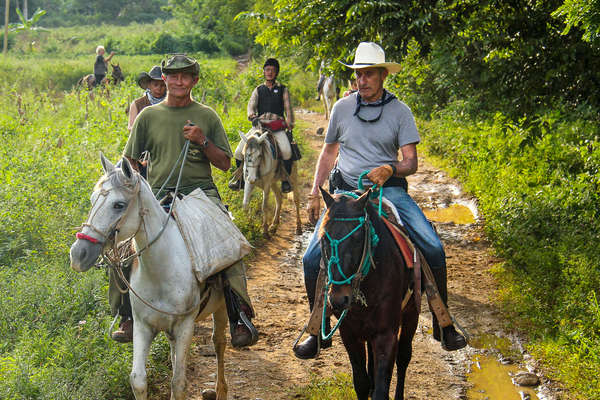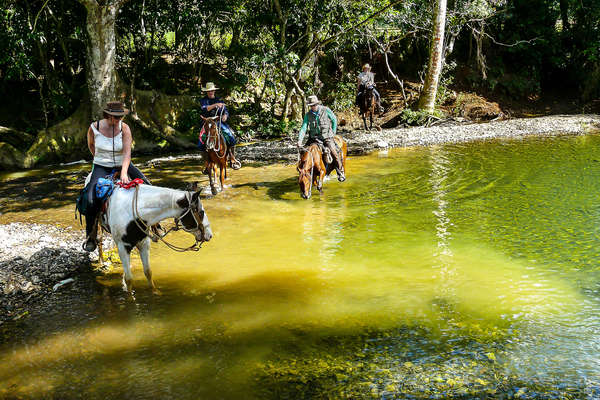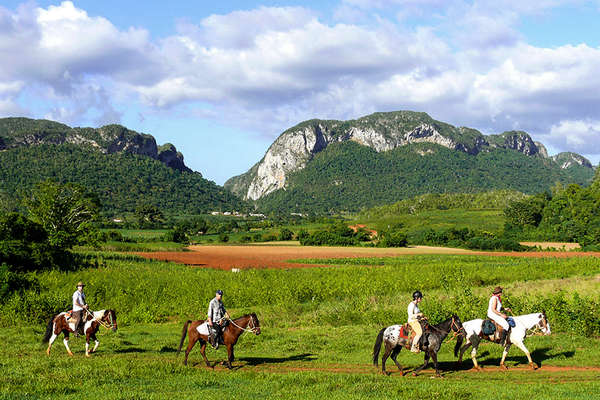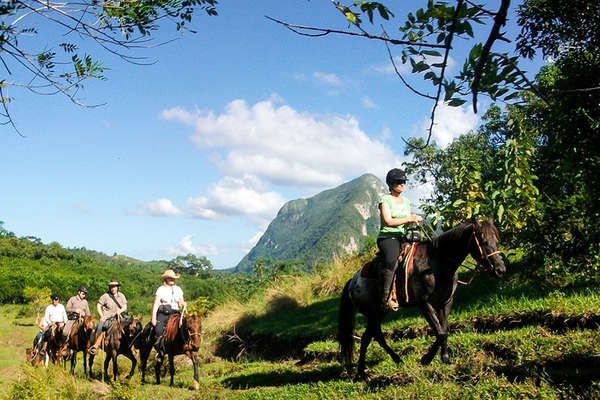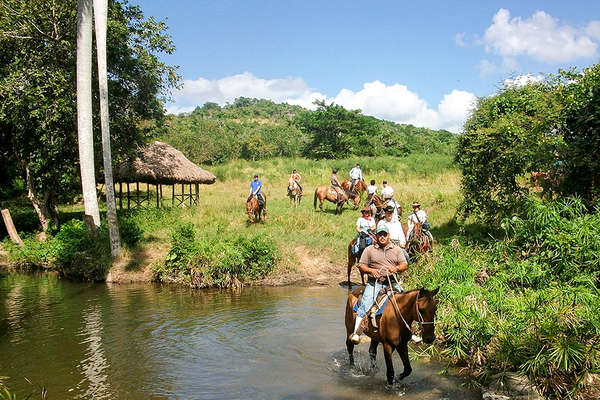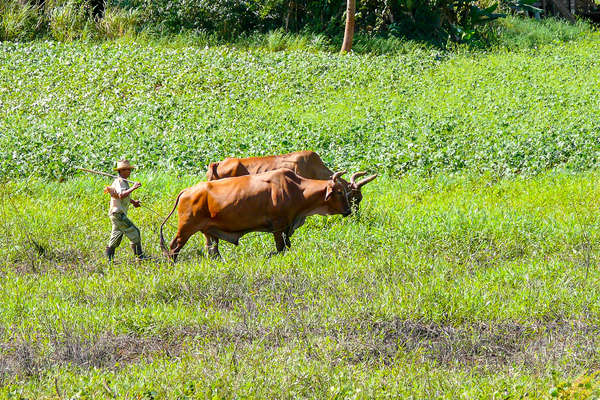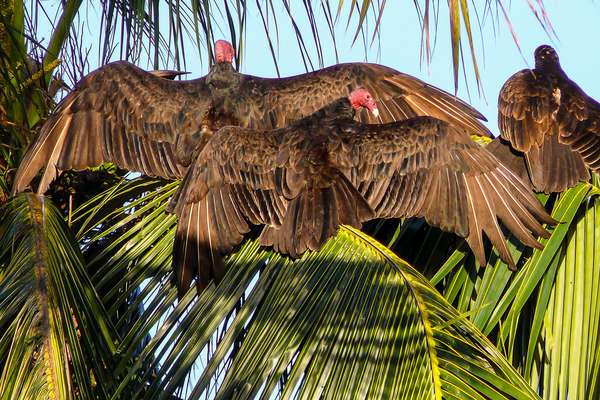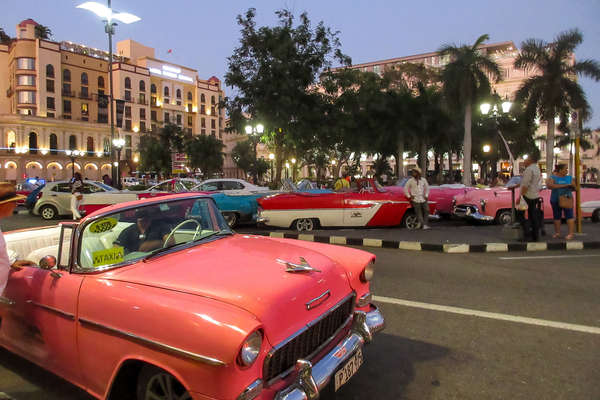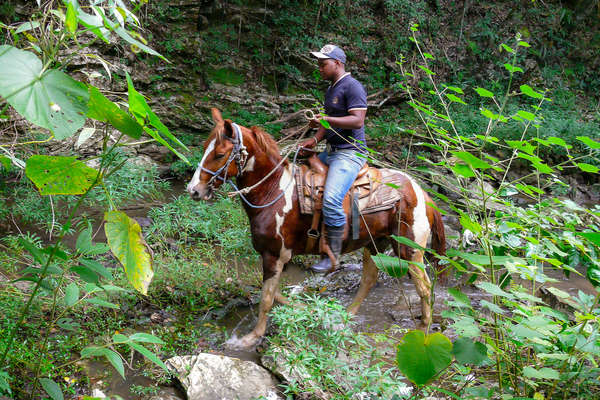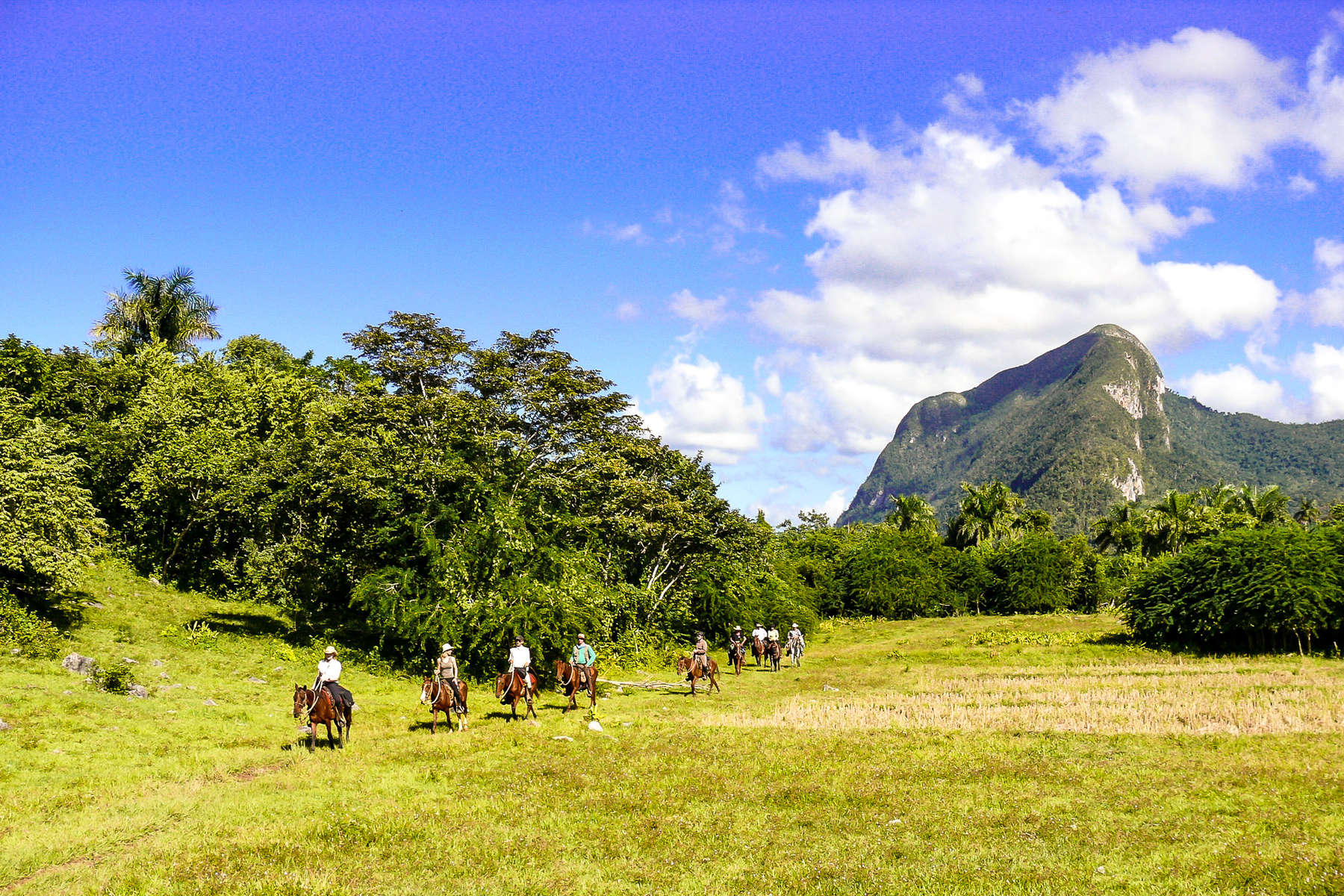
Itinerary
Highlights
- Ride through the Viñales Valley National Park, listed as a World Heritage site by UNESCO and home to the unique dome-shaped mogotes
- Spend 1 ½ days in Havana, one of the most exciting cities in the Caribbean
- See the intriguing mixture of colonial and Spanish architecture that is typical throughout Cuba
- Enjoy evenings spent dancing to the rhythm of salsa and Creole music
- Immerse yourself in the hospitality and the friendliness of the Cubans
- The long transfers are done in comfortable mini-buses.
Dates & prices
Price details
- Flights to your destination (international/domestic) are not included, but can be booked on request - please contact us for rates.
- Rates are per person, based on two riders sharing a twin or double room.
- Group size: usually a minimum of 5 to 12 international riders, plus guides.
- There is a single supplement of approx.€220/£195/$220 if you are in a single room (and no sharer is found). Payable locally. If you would like to specifically request a single room then this will be simply invoiced upon booking.
- Transfers: the first transfer from the airport to Havana is not included and payable locally (taxi fare). Included in the price is a transfer to Havana airport on the final day leaving at 18:00. If you require an earlier/later transfer time, this is not included in the cost, please contact us for details.
- You must have taken out medical and travel insurance BEFORE arriving into Cuba (please bring a Spanish copy). To enter Cuba, British nationals must have a visa, known as a tourist card, which allows for a stay of 30 days and is valid for a single entry. The cost for a tourist card is approx. £26.
- The weight limit for this ride is 14 st/198 lb/90 kg, please contact us if you are an experienced rider exceeding this weight
IMPORTANT:
Prices are linked to the CUC rate of exchange and may be changed, up to 2 weeks before the ride departure, if there is a significant change in the rate
Please Note
The itinerary may be modified at anytime for security reasons, meteorological or events beyond our control such as blocked roads, rivers in flood, drought, strikes and local holidays. Equus Journeys, our local partners and their local guides will always strive to find the best solution and will alter the itinerary as needed.
The names of the hotels and accommodation are given for information only and depending on availability, they may be modified without notice and replaced by another of a similar standard.
Price includes
Support Team
1 or 2 local equestrian guide(s) during the trail
Logistics
1 support vehicle
Inland transport
Accommodation
Meals
Price doesn't include
Meals
Meals in Havana not stated in the itinerary
Transports
Taxi fare from the airport to the hotel on day 1
Extras
Small group supplement - see above for the details
Park, museum and other site entry fees
Tourist card to enter Cuba
Insurance
Optional
Accommodation
Equestrian info
Horses
Guide & local team
You will also be accompanied by a second Cuban equestrian guide.
Minimum riding ability
Minimum riding ability
Pace
Tacking ability and participation
Trip conditions and Requested experience
It is recommended that if you do not ride regularly, you should get back in the saddle before the trip to once more get used to riding long distances.
Visiting a new country offers the opportunity to meet other cultures with different mentalities, therefore it is important to accept these differences and respect the local way of life.
Equestrian equipment
Travel info
Comfort
The accommodation at Mil Cumbres is more basic - it has two double rooms with a shared bathroom, plus a dormitory style room with 6 beds which has its own bathroom. Single rooms are not possible here.
In Havana you will stay in a small hotel, unpretentious but chosen for its excellent location. You will stay in double rooms with a private bathroom.
Meals
Vegetarian options are available.
Cubans eat at all hours and are not used to eating fruit during meals but rather throughout the day as snacks.
Make sure you don’t drink water from any source of which you are not certain that the water is potable.
Climate
The dry season lasts from around November to May with an average temperature of around 25°C. The temperature can drop to as low as 14°C and in a country that’s not built to be cold you can feel it!
The rainy season kicks off in June and lasts until October/ November. Heavy but short rain storms are typical, alongside hot temperatures – with an average of 27-28 °C.
Tips
Packing list
Head
- A riding helmet is compulsory and we recommend that you take your own to ensure a correct fit. Helmet makers (GPA, HKM, LAS Helmets, Lamicell, Troxel, Equithème) now offer horse-riding helmets that are ventilated, strong, light and comfortable. You also have the option of buying protective shells to go under your hats (Ranch & Rider, Lexington Safety Products) or western hat helmets (Troxel).
- Sunhat (indispensable)
- Sunglasses with high protection lenses - with a cord attached so they don't fly off when riding
- Buff or bandana for protecting your neck and face from the sun, wind or rain
Upper body
- T-shirts in cotton and long-sleeved shirts (to protect against the sun) or t-shirts made from rapid-dry material
- 1 lightweight fleece or jumper
- 1 lightweight waterproof jacket made from Gore-Tex or a similar material that is waterproof and breathable
Legs
- 2 pairs of lightweight, comfortable riding trousers or jodhpurs - we recommend riding in them at home before taking them on holiday to ensure they don't rub
- 1 change of riding trousers or jeans
- A swimming costume and a towel
- Non-irritant cotton or synthetic underwear
Hands and Feet
- 1 pair of comfortable riding or walking boots. We recommend short boots with half-chaps specifically for riding. We don't recommend taking your favorite leather boots in case they get damaged
- 1 pair of lightweight shoes or trainers for the evenings
- Several pairs of socks
- Gloves - your hands are particularly exposed to the sun whilst riding
Other useful items
- Travel bag 60-80 liters (hold luggage)
- Travel bag 25-30 liters (cabin bag)
- Double saddlebags are available on request; Only in some places saddlebags are included
- Water bottles - 2 bottles x 0.5L
- Headtorch or small torch for moving around at night - bring spare batteries and bulbs
- Toiletries
- Protein or cereal bars for the longer stretches of riding
- Toilet paper and a lighter to burn it after use
- Swiss army knife or equivalent (in checking-in luggage!!)
- Small plastic bags for you rubbish
- Ear plugs (may be useful)
- Camera and high capacity memory card. Spare battery
- A pair of binoculars
Medical kit
Cuba's pharmacies are woefully void of pharmaceuticals, both prescription and over the counter. There are dollar only "Tourist Pharmacies", but your best bet is to bring with you whatever you may even remotely THINK you may need.
Make sure any allergies (to medication or otherwise) are clearly stated in your medical kit
- Any medication you regularly take
- Painkillers
- Imodium or similar anti-diarrhea medication
- Vitamin C tablets
- Sunscreen and lip balm - should be high factor
- Insect repellent
- Eye drops
- Hydrating/ soothing cream
- Plasters
- Blister plasters in case of any rubs
- Antiseptic cream, plasters, aspirin, anti-histamine, insect-bite salve etc..
- 10cm wide bandage
- Spare prescription glasses/contact lenses
- Re-hydration sachets
- Antiseptic wipes
- Handwash gel
Our Recommendations
- Backpacks cannot be worn whilst riding. We recommend a small bumbag or a coat with pockets so that you can carry small items with you during the day (camera, sunscreen, lip balm etc)
- A soothing cream may be useful to treat areas irritated by long hours in the saddle
- We recommend travelling in your riding boots and carrying your hat and some riding clothes in your hand luggage - then if your luggage goes astray you are still able to ride!
- We recommend taking a copy of your passport and insurance documents with you in case you lose your originals. Your insurance policy must be in Spanish.
- Hand luggage mustn't contain any sharp objects (knives, scissors, nail file or nail scissors, etc.) and the quantity of liquid allowed per passenger is limited to 100ml per container. Check with the airline for their imposed weight limits for hand/ hold luggage.
- If you wish to travel 'light' and wash your clothes throughout the ride, please bring with you laundry detergent that is biodegradable
Sustainable tourism
- Travel light. It's a little known fact, but the lighter you pack, the better for the environment as heavy bags will produce higher emissions (when flying a plane or driving a car!).
- Reduce plastic waste. Take your favorite reusable bottle with you. Avoid single-use bags, cups, or straws.
- Preserve nature. Always take your rubbish with you during the ride and recycle them. Leave all the flowers or plants as you found them, and never get too close when observing wildlife. Make sure to use eco-friendly products such as body wash or laundry detergent (if camping) to protect both your skin and the environment.
- Choose your experiences carefully. Respect animal life by not participating in any activities that abuse wild animals (shows, elephant rides, etc.).
- Support local populations. Buy local handicrafts, be respectful of customs, and learn about the culture of local communities.
- Share! Raise awareness among your family and friends about sustainable tourism.
Did you know?
Did you know?
Habano, the urban cigar.
Considered as the best in the world by cigar smokers, the habano is the emblem of Cuban culture. It’s great aromatic complexity is provided by the Cuban territory.
The province of Pinal del Rio is recognised as the most popular land for tobacco plantations, where we find the most cape leafs. (those that surround the cigar).
Benefiting of a Protected Designation of Origin, cigars can only obtain the name of habano if it is rolled in Cuba and made from tabacco planted, harvested and manufatured in the country.
You will have the opportunity to savour one during your ride in Cuba.
Habanos have only been exported from Havana since the XIX century, following the abolition of the royal monopoly by the spanish king Ferdinand VII.

